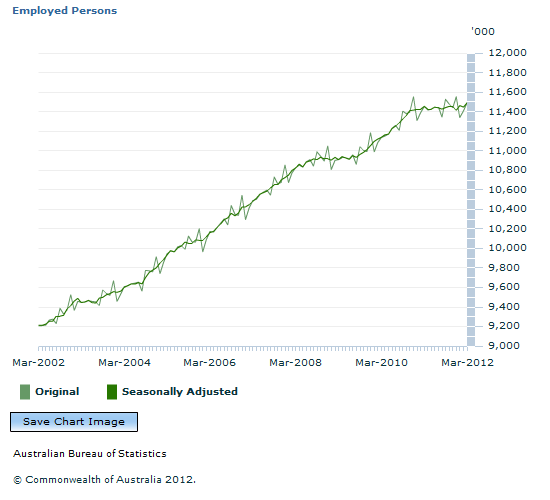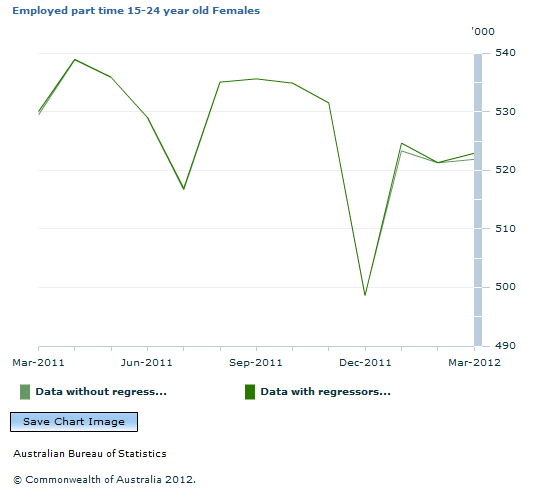6202.0 - Labour Force, Australia, Mar 2012  Quality Declaration
Quality Declaration
ARCHIVED ISSUE Released at 11:30 AM (CANBERRA TIME) 12/04/2012
Page tools:
 Print Page Print Page
 Print All Print All
| ||
ANNUAL SEASONAL REANALYSIS (ASR) WHAT IS SEASONAL ADJUSTMENT? The data for the Labour Force, Australia publication are collected regularly and use the same methods and definitions every time, giving us an Original Time Series. Seasonal adjustment is then applied to some of the series to remove influences that are systematic and calendar-related. For example, every February the unemployment rate increases because of school leavers joining the labour force. As it has the same timing, direction and magnitude every year, the movement is removed to create the seasonally adjusted series. Seasonally adjusted estimates are revised each month to take account of the latest original estimates. However, there are also some events which move around between months but which still occur every year and which have a systematic impact on the labour force data, Easter being one example. The purpose of producing seasonally adjusted series is to help people compare data. These series can be used to better inform month-to-month comparisons. Places and groups that have different labour force patterns can be compared, and they can also assist with short term forecasting. WHAT IS MOVING HOLIDAY ESTIMATION AND REMOVAL? The goal of the ABS is to ensure the production of high quality seasonally adjusted estimates that are without systematic calendar related variation. This process involves the estimation and removal of volatility due to holidays that move with respect to the LFS interview period. These include holidays such as Easter and New Year's Day, which can cause time series to be more volatile by affecting the estimate for a given month in some years but not in others. These effects can also arise when a holiday moves frequently between the two reference weeks of the survey, for example Melbourne Cup Day. Because different proportions of the sample are interviewed in each of the reference weeks, the size of the holiday impact varies accordingly. The presence and size of moving holiday effects are estimated using a regression-ARIMA framework. By implementing and maintaining appropriate regressors, the effects caused by moving holidays, and other non-regular calendar related events, can be accurately estimated and removed from the seasonally adjusted time series estimates. Without accurate estimation of these effects, the seasonal pattern may be obscured, and the seasonal factor estimates may be less accurate. Seasonally adjusted employment estimates include a correction for Easter and New Year’ Day effects. Seasonally adjusted aggregate hours worked estimates include more extensive correction for public holiday and school holiday effects. These are estimated and removed in the aggregate state/territory estimates using a regressor for each moving holiday effect. State level regressors and effect sizes are used to create regressors appropriate for estimating the school and public holiday effects in the Australia and full-time/part-time by sex estimates. During an annual seasonal reanalysis, the moving holiday estimation framework is assessed for appropriateness. This is to ensure that the effect sizes are being appropriately estimated from year to year, that assumptions used in the regression framework continue to be valid, and to implement improvements in estimation methodology. In 2012, the framework was updated to include information about average hours worked per weekday and about the proportion of the LFS sample interviewed in the first and second weeks of reference period. This has resulted in a more accurate estimation of the effect of moving holidays on aggregate hours worked. This quality improvement will result in some greater than average revisions between February and March 2012. IMPACT ON THE LABOUR FORCE DATA The annual seasonal reanalysis does not normally result in significant changes to published estimates. Alongside the normal month to month revisions, there are no extreme observable changes in the series from the ASR. For the period February 1978 to February 2012, the employed persons level estimate changed by an average absolute monthly change of 100 persons, which includes both the normal seasonal adjustment process and the results of the annual seasonal reanalysis. The largest revision to the employed persons estimate was a decrease of 6,300 persons in March 2011. The unemployed persons estimate changed by an average absolute monthly change of fewer than 100 persons. The largest revision to the employed persons estimate was a decrease of 500 persons in March 2009. Aggregate hours worked was revised by an average absolute monthly change of 1.2 million hours. The largest revision to the aggregate hours worked estimate was a decrease of 10.3 million hours in May 1985. FURTHER INFORMATION For any queries regarding the implementation of these changes contact Labour Force Estimates on Canberra 02 6252 6525, or via email at labourforce@abs.gov.au. Document Selection These documents will be presented in a new window.
|
||



.gif)
.gif)
.gif)